Biology MCQs with answers for NEET Environmental Issues
Question 1. World Summit on Sustainable Development (2002) was held in
- Brazil
- Sweden
- Argentina
- South Africa
Answer: 4. South Africa
World Summit on Sustainable Development (2002) was held in Johannesburg, South Africa. 190 countries pledged their commitment to achieving by 2010, a significant in reduction the current rate of biodiversity loss at global, regional, and local levels.
Question 2. Match the items given in Column I with those in Column II and select the correct option from the codes given below.
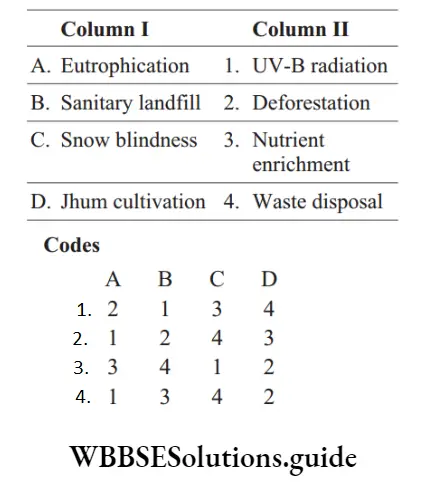
Answer: 3. A–3, B–4, C–1, D–2
Read And Learn More: NEET Biology Multiple Choice Question And Answers
Question 3. Sustainable environment means
- Disturbed Environment
- Polluted Environment
- Non-Developing Environment
- The environment which can be maintained
Answer: 4. Environment which can be maintained
Environmental sustainability is our responsible interaction with the environment to avoid depletion or degradation of natural resources and allow for long-term environmental quality. Thus, a sustainable environment means an environment that can be maintained.
Question 4. Strengthening of the concept of environmental monitoring is due to concern for the
- Quality Of Environment
- Quantity Of Environment
- Quality Of Monitor
- Pure air
Answer: 1. Quality Of Environment
The strengthening of the concept of environmental monitoring is due to concern for the quality of the environment. Environmental monitoring is a tool to assess environmental conditions and trends, support policy development and its implementation, and develop information for reporting to national policymakers, international forums, and the public.
Biology MCQs with answers for NEET
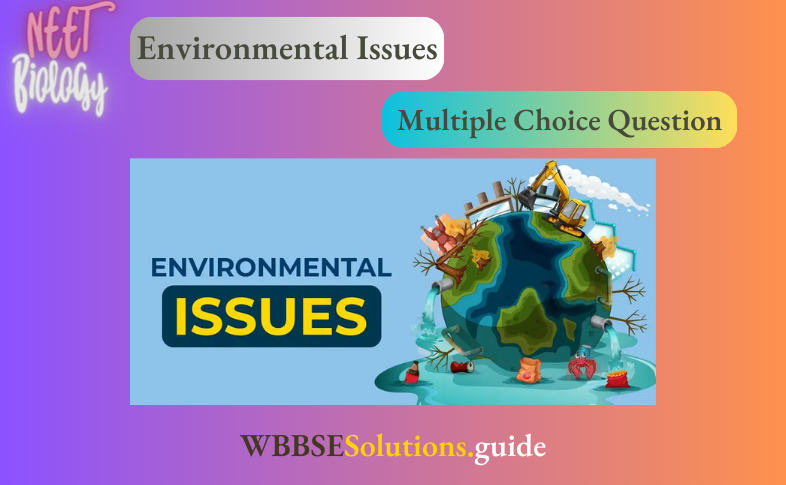
Question 5. Consider the following statements.
- By the end of the twentieth century, the forest cover in India was reduced to 19.4%.
- National Forest Policy was implemented in the year 1988.
- The average annual production of dry grass or hay in India is about 250 million tons.
- About 10% of the world’s population lives in arid or semiarid regions.
Choose the option containing the correct statements.
- Statements 1 and 4 are correct
- Statements 1, 3, and 4 are not correct
- Statements 1, 2, and 3 are correct
- Statement 3 is not correct
Answer: 3. Statements 1, 2, and 3 are correct
Statements 1, 2, and 3 are correct whereas 4 is incorrect. Incorrect statements can be corrected as Roughly 2.5 billion people, 30% of the world’s population, live in the dry areas, which cover more than 40% of the world’s land surface.
Question 6. Match the following columns.
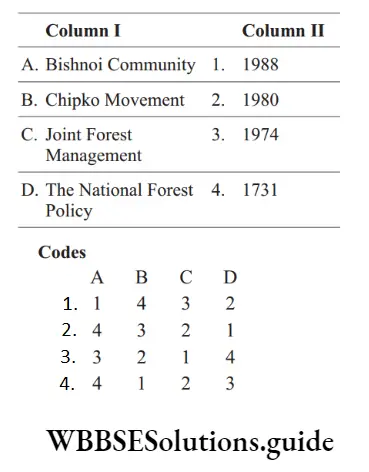
Answer: 2. A–4, B–3, C–2, D–1
Question 7. Identify the correctly matched pair.
- Kyoto Protocol – Climate change
- Montreal Protocol – Global warming
- Basal Convention – Biodiversity conservation
- Ramsar Convention – Groundwater pollution
Answer: 1. Kyoto Protocol – Climate change
Option 1 is a correctly matched pair, but other options are incorrectly matched and can be corrected as the Montreal protocol was about the depletion of the ozone layer. The basal convention was about hazardous waste and the Ramsar Convention was for the conservation and sustainable use of wetlands. Kyoto Protocol happened in 1997 was about climate change.
Question 8. Consider the following statements with respect to pollution.
- To control air pollution problems, by the end of 2002, all the buses of Delhi were converted to run on unleaded petrol.
- An electrostatic precipitator can remove over 99% of particulate matter present in the exhaust from a thermal power plant.
- It is possible to estimate the amount of organic matter in sewage water by measuring BOD.
Choose the option containing the correct statement(s).
- Statement 1 alone is correct
- Statement 2 alone is correct
- Statement 3 alone is correct
- Statements 1 and 2 are correct
- Statements 2 and 3 are correct
Answer: 5. Statements 2 and 3 are correct
Statements 2 and 3 are correct, whereas 1 is incorrect. Incorrect statements can be corrected as With its very large population of vehicular traffic, Delhi leads the country in its levels of air pollution. Under the directives of the Supreme Court of India, the government was asked to take, within a specified time, appropriate measures, including switching over the entire fleet of public transport, i.e. buses from diesel to Compressed Natural Gas (CNG). All the buses of Delhi were converted to run on CNG by the end of 2002.
Biology MCQs with answers for NEET
Question 9. NEERI is at
- New Delhi
- Nagpur
- Kolkata
- Chennai
- Rajasthan
Answer: 2. Nagpur
NEERI is a National Environmental Engineering Research Institute at Nagpur, which monitors environmental pollution.
Question 10. Consider the following statements.
- Soil with a vegetation cover is easily eroded by both wind and water.
- Excessive irrigation results in water logging of soil.
- Increased salt concentration damages agriculture.
Which of the statements given above is correct?
- 1 and 2
- 1 and 3
- 2 and 3
- 1, 2 and 3
Answer: 3. 2 and 3
Statements 2 and 3 are correct whereas statement 1 is incorrect and can be corrected as Soil without vegetation cover is easily eroded by both wind and water.
Read And Learn More: NEET Biology Multiple Choice Question And Answers
Question 11. Match the following columns.
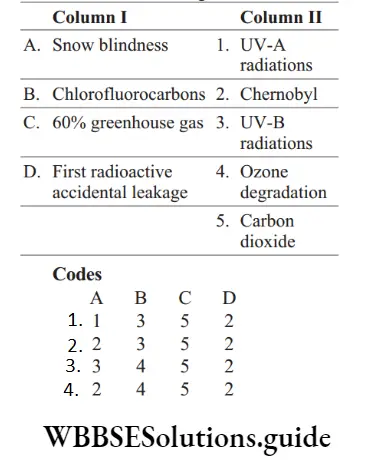
Answer: 3. A–3, B–4, C–5, D–2
Question 12. The oxygen concentration at the floor of the deep ponds and lakes is very low because of the
- Overhanging Column Of Water
- Lesser Amount Of Sunlight
- Decomposers
- A large number of annual inhabitants
Answer: 2. Lesser Amount Of Sunlight
The oxygen concentration at the floor of the deep ponds and lakes is very low because of the lesser amount of sunlight.
Biology MCQs with answers for NEET
Question 13. Recently the Government of India has allowed the mixing of alcohol in petrol. What is the amount of alcohol permitted for mixing in petrol?
- 2.5%
- 10-15%
- 10%
- 5%
Answer: 4. 5%
Alcohol to the tune of 5% is allowed to be mixed in petrol as per the Government of India’s decision.
Question 14. Which one of the following combinations is wrong?
- Rio convention – Air pollution
- Kyoto Protocol – Climate change
- Montreal protocol – Ozone depletion
- Ramsar convention – Wetland conservation
Answer: 1. Rio convention – Air pollution
Option 1 is the wrong combination and can be corrected as The three Rio conventions
Question 15. IRRI proposed one of the following for the prevention of fertilizers pollution in agriculture
- Trickling Filter Method
- Mud Ball Technique
- Both 1 and 2
- None of the above
Answer: 3. Both 1 and 2
International Resources and Recycling Institute is one of the groups which proposes certain methods that help in the reduction of pollution. The group proposed two methods, i.e. trickling filter method and the mud ball technique which can be used for the prevention of pollution by fertilizer in agriculture.
Biology MCQs with answers for NEET
Question 16. The mudball technique has been proposed by
- Rice Research Institute, Cuttack
- CSIR, New Delhi
- Punjab Agriculture University, Ludhiana
- The International Rice Research Institute, Philippines
Answer: 4. The International Rice Research Institute, Philippines
The mud ball technique is a Japanese art form of binding mud and water to form a fine ball. This technique has been used by IRRI, Philippines as a method of fertilizer application to rice fields. This method reduces the amount of fertilizer applied but retains the output of rice.
Question 17. What was the cause of the ‘Yusho’ disease which occurred in 1968 from a leak in a 1968 canning factory?
- DBCP
- PCB
- Formaldehyde
- Mercury
Answer: 2. PCB
Yusho disease (literally oil symptoms) was a mass poisoning by Polychlorinated Biphenyls (PCBs) which occurred in Northern Kyûshû, Japan in 1968.
Question 18. In a polluted environment, the maximum pollutant will occur in
- Primary Producers Amu
- Tertiary Consumers
- Secondary Consumers
- Primary consumers
Answer: 2. Tertiary Consumers
In a polluted environment, the maximum pollutant will occur in tertiary consumers.
Biology MCQs with answers for NEET
Question 19. Match the following columns and select the correct option from of codes given below.
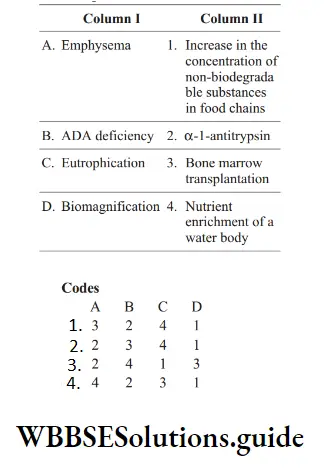
Answer: 2. A–2, B–3, C–4, D–1
Question 20. Match Column I with Column II.
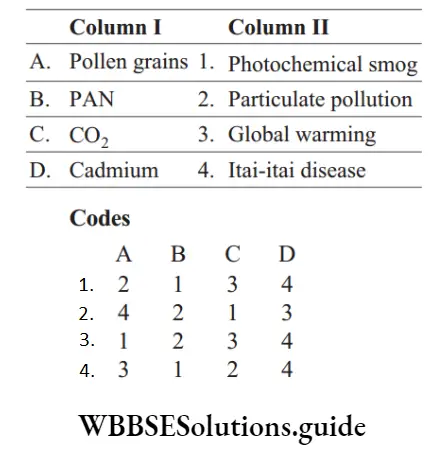
Answer: 1. A–2, B–1, C–3, D–4
Question 21. Find out incorrect statements in relation to pollution.
- Plastic is a non-degradable pollutant
- Water vapors, smoke fumes and dust mixture form smog
- PAN affects photosynthesis
- The ozone layer forms a protective shield in the ionosphere
Answer: 4. Ozone layer forms a protective shield in the ionosphere
The statement in option 4 is incorrect in relation to pollution and can be corrected as the Ozone layer forms a protective shield in the stratosphere. Rest statements are correct about pollution.
Question 22. Which one of the following is being tried in India as a biofuel substitute for fossil fuels?
- Jatropha
- Azadirachta
- Musa
- Aegilops
Answer: 2. Azadirachta
Azadirachta is being tried in India as a biofuel substitute for fossil fuels. Biofuels are fuels of biological origin. They constitute a renewable form of energy. Energy problems can be solved up to a great extent by efficient and proper use of these biofuels.
Biology MCQ For NEET With Answers
Question 23. Match the following columns and choose the correct option from the codes given below.
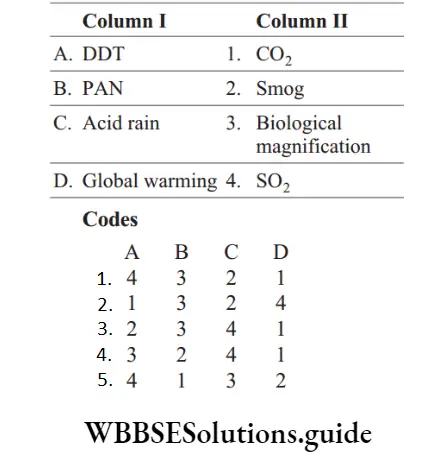
Answer: 4. A–3, B–2, C–4, D–1
Question 24. Which of the following are correctly matched?
- Arsenic poisoning – Black-foot disease
- Secondary effluent treatment – Biological process
- Pyrolysis – Solid soil waste disposal
- Tubifex –Water pollution indicator
- Biomagnification – Degradable pollutants
Choose The Correct Option
- 1, 2, 3 and 5
- 1, 3, 4 and 5
- 2, 3, 4 and 5
- 1, 2, 3 and 4
Answer: 4. 1,2,3 and 4
All pairs are correctly matched except pair V. Incorrect matched pair can be corrected as Biomagnification–Non-degradable pollutants
Question 25. The green revolution was carried out in order to
- Decrease The Use Of Modern Farm Equipment
- Decrease Population Growth
- Make India Self-Sufficient In Food Grains
- Make India self-sufficient in milk production
Answer: 3. Make India Self-Sufficient In Food Grains
In India, the major goal of the green revolution was to increase agricultural production. MS Swaminathan initiated collaboration with Dr. Borlaug which reached the highest point into the green revolution through the introduction of Mexican varieties of wheat in India. Green Revolution depends mainly on plant breeding techniques for high-yielding and disease-resistant varieties in wheat, rice, maize, etc. Thus, the green revolution was carried out in order to make India self-sufficient in food grains.
Biology MCQ For NEET With Answers
Question 26. Which of the following statements is incorrect?
- Carbon monoxide is the major environmental pollutant
- All pollutants are waste
- Nitrogen (N) and magnesium (Mg) can pollute water
- Lichens are affected by sulfur dioxide
Answer: 2. All pollutants are waste
The statement in option 2 is incorrect and can be corrected as All processes create waste, but not all will create pollution. Since not all waste is harmful, not all waste is pollution. When waste is indeed harmful, it would then be classified as pollution. The rest statements are correct.
Question 27. Fill up the blanks.
- The effects of biomagnification of …A… and …B… can be observed significantly.
- …C… poisoning can be observed in paper and paint industries.
- …D… separation is carried out by scrubbers.
- …E… is the first city in the world whose public transport system will completely run on CNG.
Complete the given set of statements by choosing appropriate options.
- A–phenol, B–nitrates, C–Heavy metals, D–Dust, E–Bengaluru
- A–lead, B–Copper, C–Inorganic compound, D–Wastewater, E–Mumbai
- A–mercury, B–DDT, C–Heavy metals, D–SO2, E–Delhi
- A–sodium, B–calcium, C–Organic compound, D–Dirty air, E–Chennai
Answer: 3. A–Mercury, B–DDT, C–Heavy metal, D–SO2, E–Delhi.
Question 28. Match the following items in Column I with Column II and choose the correct option from the codes given below.
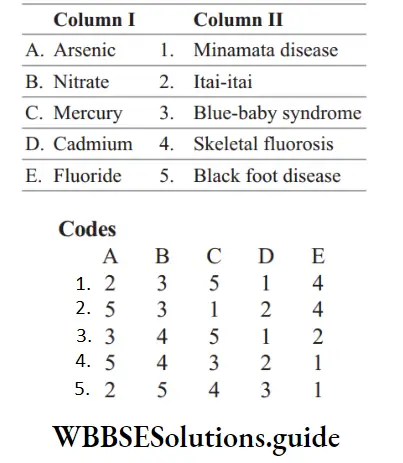
Answer: 2. A–5, B–3, C–1, D–2, E–4
Question 29. Who among the following called as Father of the White Revolution?
- Norman Borlaug
- Verghese Kurien
- MS Swaminathan
- Lakdawala
Answer: 2. Verghese Kurien
The white revolution, known as Operation Flood, was launched in 1970. It was an initiative by India’s National Dairy Development Board (NDDB) and was the world’s biggest dairy development program. It transformed India from a milk-deficient nation into the world’s largest milk producer. Operation Flood was based on the experimental pattern setup by Verghese Kurien, chairman and founder of AMUL, who was named the Chairman of NDDB and was also recognized as the architect of operation flood. So, Verghese Kurien is called the as Father of the white revolution.
Biology MCQ For NEET With Answers
Question 30. The pollution in a city like Delhi may be controlled to a great extent
- By Proper Sewage And Proper Exit Of Chemicals From Factories
- By Wide Roads And Factories Away From The City
- By cleaning the city and scanty use of pesticides
- All of the above
Answer: 4. All of the above
All the given options are great extent the pollution in a city like Delhi may be controlled.
Question 31. Which of the following organisms is useful in degrading organic pollutants?
- Nitrosomonas
- Chlamydia
- Actinomycetes
- Pseudomonas
Answer: 4. Pseudomonas
Pseudomonas is a bacterium which is a decomposer and degrades organic matter.
Question 32. Which of the following is employed for clearing oil spillage?
- E. coli
- Bacillus thuringiensis
- Pseudomonas
- Streptococcus
Answer: 3. Pseudomonas
Oil spill biodegradation is a process of removal of petroleum and other hydrocarbon pollutants from the environment, Microorganisms namely Pseudomonas, Mycobacterium were found to be molded in alkyl aromatic (hydrocarbon) oil spill degradation
Question 33. Restoration of ecological equilibrium in mined areas can be achieved through
- Revegetation Of The Mined Habitats
- Conversion Of Mined Habitats Into Agricultural Ecosystems
- Prevention Of Soil Erosion
- Prevention of grazing
Answer: 1. Revegetation Of The Mined Habitats
Revegetation is the process of replanting and rebuilding the soil of disturbed land. This may be a natural process produced by plant colonization and succession, man-made rewilding projects, or accelerated process designed to repair damage to a landscape due to wildfire, mining, flood or other cause. Thus, restoration of ecological equilibrium in mined areas can be achieved through revegetation of the mined habitats.
Biology MCQ For NEET With Answers
Question 34. Pollution from animal excreta and organic waste from kitchen can be most profitably minimized by
- Storing Them In Underground Storage Tanks
- Using Them For Producing Biogas
- Vermiculture
- Using them directly as biofertilizers
Answer: 2. Using Them For Producing Biogas
Pollution from animal excreta and organic wastes from kitchen can be most profitable minimised using them in the generation of biogas. Biogas is a mixture of methane and carbon dioxide resulting from the anaerobic decomposition of such waste materials as domestic, industrial and agricultural sewage.
Question 35. Main component of biogas is
- CO2
- HS2
- SO2
- CH4
- O2
Answer: 4. CH4
The main component of biogas is methane (CH4). Methane is also an important constituent of natural gas. methane has high heat of combustion.
\(\mathrm{CH}_4+2 \mathrm{O}_2 \longrightarrow \mathrm{CO}_2+2 \mathrm{H}_2 \mathrm{O}+\text { Heat }\)Question 36. A mutagen pollutant is
- Organophosphates
- Resins
- Chlorinated Hydrocarbons
- Nitrogen oxides
Answer: 3. Chlorinated Hydrocarbons
Mutagenic pollutants are those that cause mutation in DNA cells. Metabolites of Polycyclic Aromatic Hydrocarbons (PAHs) are mutagenic as they act as carcinogenic, e.g. acenaphthene. The source of PAHs can relate to the chemical industrial process burning of fossil fuels, etc.
- Organophosphates are non-degradable pesticides
- Resins are waste materials produced by the plants
- Hydrocarbons are carcinogenic
- Nitrogen oxides cause air pollution and acid rain.
- Hence, the correct answer is chlorinated hydrocarbons.
NEET Biology Mcq Chapter Wise
Question 37. Which one of the following is an environment-related disorder with the correct main cause?
- Black lung disease (pneumoconiosis) found mainly in workers in stone quarries and crushers
- Blue baby disease (methemoglobinemia) due to heavy use of nitrogenous fertilizers in the area
- Non-Hodgkin’s lymphoma is found mainly in workers involved in the manufacture of neem-based pesticides
- Skin cancer mainly in people exposed to benzene and methane
Answer: 2. Blue baby disease (methemoglobinemia) due to heavy use of nitrogenous fertilizers in the area
Blue baby syndrome is blood-related condition found in babies due to nitrate poisoning (poisoning limits blood’s ability to carry oxygen thereby causing baby to look blue), known as methemoglobinaemia. This is a serious illness in infants which is caused when nitrate is converted into nitrite in the infant’s body. Nitrite capacity of the child’s blood (it replaces the oxygen on the red blood cells). This is an acute disease in which symptoms can develop rapidly in infants. However, in most cases, health deteriorates over a period of days. Clearly, expert medical advice should be sought immediately if these symptoms occur. So, blue baby disease occur due to heavy use of nitrogenous fertilisers is an evironmental related disorder.

